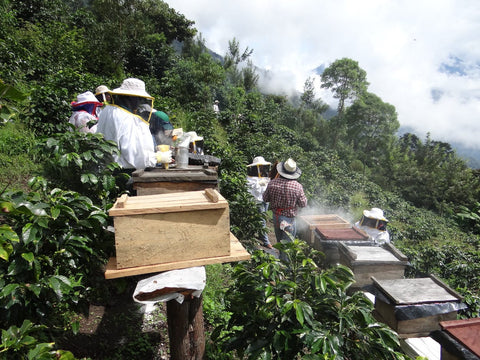First Published - June 29, 2012
How is coffee grown?
Young coffee plants are grown in nurseries, shown here which is in Guatemala.
Here coffee producers grow new young coffee plants in a special format so they can be transplanted into the land parcels within the first year. The plants are either grown in plastic plant pot-bags as in the picture or directly into the ground. The plants are placed neatly in rows because one needs to have room around the plants to fertilize and to weed the surrounding area (to avoid disease transmission).
Why is crop diversity important?
The farmers often grow other crops too, for a variety of reasons; to give shade to coffee plants, to provide for their own food needs, and to have other sources of cash crops to contribute to their income outside of the coffee season. Here’s a great project in Huica that Pascale visited:
The women of Huica have a mushroom project, which not only provides an alternative income source but also diversifies their diet. They grow the mushrooms in an old barn that has the correct moisture and light levels.
There are different ways to cultivate mushrooms. These women use maize stalks as the growth medium, which are abundant because tortillas which are made of maize dough feature in every meal here. Mushroom growing does not require a great investment, only the seeds and plastic bags need to be bought every time.
After approximately 45 – 60 days the mushrooms are ready to harvest. The crop can be susceptible to disease, but if taken care of properly a substantial harvest can be managed in relatively little space. The harvest takes place every two months and the sales at local markets and to friends and neighbours provides regular cash flow. During the coffee season, women often stop mushroom cultivation, as coffee requires all of their time. And they need to use the barn to dry and store their parchment coffee.
Coffee ready to be picked:
Still green and immature coffee beans are shown here together with new coffee flowers not yet opened. The flowering of the coffee plant is dependent on several factors, most importantly rainfall.
With the first rains during the wet season the coffee plant starts to flower with coffee blossom. This is not only a magnificent sight, like these plants in Tuiboch, Todos Santos, but also brings with it a delicious aroma of jasmine.
One can often find banana or plantain trees in the coffee fields, planting both cash and food crops in the same area is an optimal way of using space.
Next time I want to discuss some of the problems and issues that can affect coffee plants during the growing season – and how farmers overcome them.







